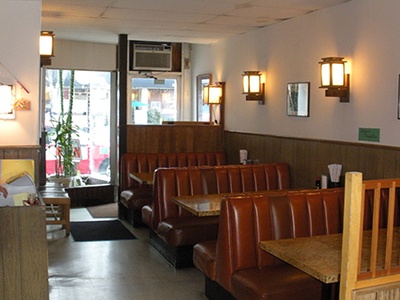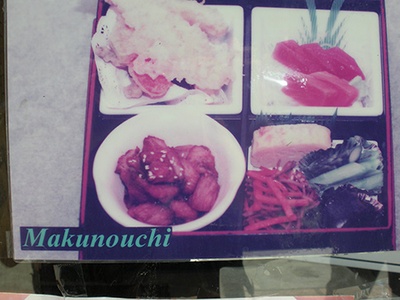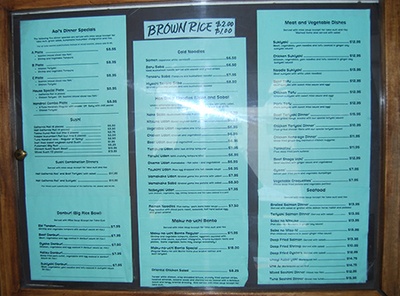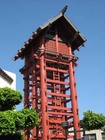Aoi Restaurant sits in the heart of historic Little Tokyo, on 1st Street in downtown Los Angeles. Half a block away from the Japanese American National Museum, Aoi is one of many restaurants, sweet shops, and cafes that line the main artery of Little Tokyo and attract people of all backgrounds to the thoroughfare.
Established in 1976 by Hiroko Yamagata and her sister Grace Maruyama, immigrants from Hiroshima, Aoi is arguably the most historic of Little Tokyo's restaurants, and well-respected for its cuisine. Hiroko shared with us during an interview at Aoi that when new restaurants are opening they will call her asking her to taste their fare, as her opinion is valued in the realm of traditional Japanese cuisine. And it should be, as Aoi has been around longer than most restaurants in Little Tokyo, and has lasted through many changes to the neighborhood. When we sat down with Hiroko, she told us that in her 33 years of owning and running Aoi, the face of Little Tokyo has transformed considerably.
In the late 1970s and 1980s, customers mainly consisted of Japanese people -- those working or living in or around Little Tokyo, or travelers from Japan, often in the form of personnel for Japanese companies on business in the U.S. looking for traditional food. At this time, Americans had not yet caught on to Japanese food and Hiroko recalls that few would have eaten raw fish, or sashimi. However, when the Japanese economic bubble collapsed in 1990, Hiroko recalls that many Japanese living in Southern California returned to Japan. New ethnic groups began coming to Little Tokyo, and Japanese food grew in popularity.
With more Americans falling in love with sushi in the 1990s, Aoi began to see customers of many different backgrounds. Hiroko and Grace told us that this trend continues, with Little Tokyo growing to include cultures besides the Japanese, with young people flocking to the neighborhood every evening to experience the cuisine and nightlife. This newfound popularity saw a shift in business owners as well, with more non-Japanese entrepreneurs buying in Little Tokyo, as well as the construction and opening of several hotels in and around the area.
And while Hiroko laments the loss of small and family-owned businesses due to the popularization and commercialization of Little Tokyo, she feels otherwise quite positively about the changes in Little Tokyo, excited about exposing different people to authentic Japanese food, and happy that the cultural expansion has helped her business grow and gain wider spread popularity.
Hiroko and Grace cite the 1984 Olympics as a prime example of the thrill of bringing together many types of people. The time was described as "nigiyaka," which means lively and exciting as well as prosperous, and they both agreed that it was fun to expose people of such diverse backgrounds to Japanese food, and also to serve traditional fare to tourists from Japan. Simple, traditional Japanese food is what Aoi is famous for and why people of all ethnicities return again and again. After dining there for lunch, the secret behind the staying power of HirokoYamagata’s establishment becomes clear.
When you enter Aoi, you are met by the enticing smells of Japanese cuisine. The establishment is smaller in size and unpretentious in its decoration and interior design. The red booths are inviting and though the room is not large, there is not too close a proximity to the other customers. This is an important quality to Aoi specifically because their dining room is normally full, as it remains one of the most popular restaurants in Little Tokyo. The lively atmosphere was exciting; walking past the other happy customers while being led to our table, I was eager to order. Many of the customers were Japanese, but at least half of the cheerful diners were not. Walking to our table I heard Japanese, English, and Spanish being spoken over the hot plates of tempura and grilled meats. The service was quick and attentive, our waiter immediately coming over to pour us green tea and ice water, and then taking our drink orders. The menu is large enough to account for many tastes but not overwhelming, and most dishes are simple, home-style Japanese food. Aoi offers udon noodles, teriyaki bowls, sashimi, and an assortment of meat and seafood dishes, including the sukiyaki stew which is popular in online and written reviews.
I opted for the makunouchi bento box to taste several different dishes while my companion orders the chicken teriyaki. While waiting I see Hiroko in the exterior part of the kitchen hard at work, while Grace runs food and payment in the front. I try to catch their attention but both are very busy with the full dining room, though Grace gives us a smile as she hurries past with a customer’s credit card. It amazes me that the sisters have been working and running this business in this exact location for over 33 years, and I am inspired by their determination and hard work. I recall Hiroko saying they had “no fear” when opening Aoi, and I imagine that this same attitude has kept the business alive and exciting since 1976.
My thoughts are interrupted by the arrival of our miso soup and rice. The miso soup was absolutely delicious and of a much better quality than what one finds at most Japanese restaurants. The broth seemed thicker and more flavorful, and I was trying to slurp out the last drop when our waiter arrives with our meals. The bento box was gorgeous and consisted of shrimp and vegetable tempura with a tasty dipping sauce, tuna sashimi, stewed eggplant, a spinach dish, and a cold pickled cucumber salad. It was an enormous amount of food for twelve dollars and everything looked and smelled amazing, so much so that I almost did not want to start destroying it with my chopsticks. The sashimi was fresh, and the tempura very lightly fried so that the flavors of the shrimp and vegetables were not at all overwhelmed by the batter. The spinach dish allowed me to believe I was being healthful while consuming such an inordinate amount of food and the cucumber salad was light and refreshing. My favorite aspect by far was the eggplant stewed in sesame miso sauce, which had a perfect soft texture and was very flavorful. My friend similarly enjoyed the chicken teriyaki, which was also of ample proportions, and said that the chicken was lean and cooked perfectly. I tasted his side salad and it was fresh and crisp with a delicious creamy dressing.
After such an affordable and pleasurable dining experience I can understand why Hiroko and Grace have been able to stay in business during the tides of change facing little Tokyo. It is no stroke of luck that this small, family-owned business is still open to serve traditional Japanese food to those visiting Little Tokyo for an authentic Japanese experience.
Discover Nikkei partnered with Professor Morgan Pitelka of Occidental College and his students taking the Spring 2009 seminar "Japanophilia: Orientalism, Nationalism, Transnationalism" on a meaningful community-based documentation project. The students interviewed owners of five long-time Little Tokyo businesses to create Nikkei Album collections and articles.
View the Nikkei Album collection: Aoi Restaurant
© 2009 Angelica Jardini






